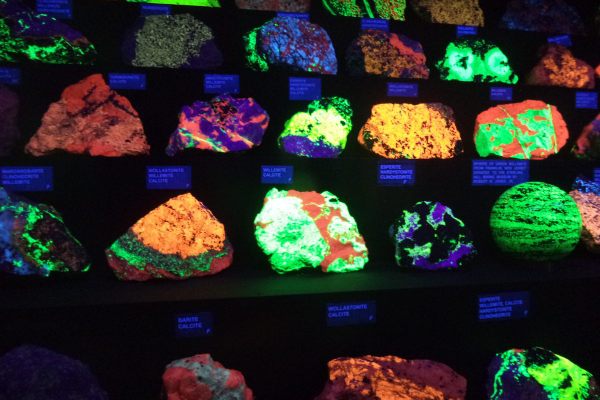How Geologists Peer Inside a Rock
After they found prehistoric fossils in the Canadian Rockies, researchers pulverized them to make 3D reconstructions.

When the Princeton University geologists Akshay Mehra and Adam Maloof, Mehra’s advisor, wanted to learn more about Cloudina—a fossilized organism that lived 545 million years ago—they decided to pulverize it.
As part of their work for a recent study, published in the Proceedings of the National Academy of Sciences, the researchers had collected samples from rocky outcroppings in Namibia and the Canadian Rockies that were once reefs. The haul was varied—the scientists had hacked off pieces of different colors and textures. Back in the lab, “we cut them down, sawed them into blocks, stuck the blocks on a metal plate using some epoxy, and then we just started grinding away,” Mehra says.
Spinning at 3,000 rpm, GIRI (short for the Princeton Grinding Imaging and Reconstruction Instrument) cuts the material into slices just a few microns thick—that’s about one-third as thick as a single strand of hair. A dribble of water-based coolant soothes the friction and flushes the ground material away. As it whirs, the machine captures a high-resolution image, “a recording of what exactly is in the rock, including color and texture information,” Mehra says. The researchers can rotate the image and get a close-up look at how the different structures relate to each other. (Watch a video of a sample from Namibia, above, which shows only the fossil tubes, and no surrounding stone.) When GIRI has chewed its way through the rock, there’s nothing left but finely ground dust.
It might seem startling to knowingly make smithereens out of millions of years of history. This strategy certainly isn’t the only way to look in: Scientists often turn to X-rays and electron microscopy to peer inside fossils, even ones still embedded in rocks. The technologies can also be helpful in allowing scientists to manipulate scale, zooming in for a closer look. “For those studying early mammals, where bones are fragile and the all-important teeth are often smaller than cous cous grains,” The Guardian noted in 2016, “micro-CT scans can enlarge your world of study so that the finest cracks in tooth enamel become veritable canyons.” Institutions can scan and share these findings, contributing to vast digital repositories.
But, Mehra says, these approaches don’t always work for any given fossil. X-rays evaluate different densities, he says—that’s why some shapes on a scan glow white, while others appear black. In the case of a fossil like Cloudina, which is chemically almost identical to the rock surrounding it, an X-ray wouldn’t tell them much. “If we stuck this rock in an X-ray machine, it would just be a big blob,” Mehra says.

Is sacrificing the original material worth it? “As ever, it all depends on knowing precisely what your research questions are and whether this technique will answer them and contribute to knowledge,” says Ruth Siddall, a geologist at University College London.
Other experts stress that minimally invasive techniques, such as those offered by other types of imaging technologies, should be ruled out first. “With CT scanning, a lot more can be done with fossil vertebrates, nowadays,” says James Kirkland, the state paleontologist with the Utah Geological Survey. When a strategy like GIRI does emerge as the best option, Kirkland adds, researchers should exercise extra caution about archiving data. Since the original will vanish, there’s no fail-safe. Though the Princeton team preserves the rock residue on a fine mesh filter—in case they want to study chemical properties later on—the data record is the most direct link to the original.
“Dinosaur bones, lunar samples—there are certain specimens that people are less likely to give us,” Maloof said in a statement. In contrast to these more precious ones, workaday samples are less likely to raise hackles. “Cloudina, there are zillions of them,” he added. “We could never grind them all.”
What they do grind, though, offers a peek deep inside a rock, and way back in time.
























Follow us on Twitter to get the latest on the world's hidden wonders.
Like us on Facebook to get the latest on the world's hidden wonders.
Follow us on Twitter Like us on Facebook